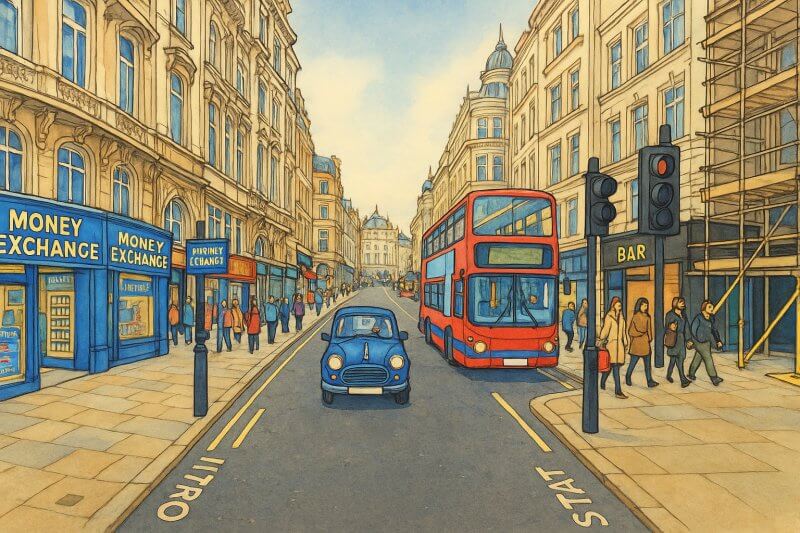
Coventry Street, London
Connecting Two Icons: The Personality of Coventry Street
Coventry Street may be short in length, but it holds a significant place at the heart of London’s vibrant West End. Lined with bright lights, theatres, entertainment venues, and restaurants, this famous stretch buzzes with life day and night, making it a must-see for anyone exploring central London.Where is Coventry Street?
Coventry Street lies in the City of Westminster, right at the heart of London’s entertainment district. It connects two of London’s most famous spots: Piccadilly Circus to the west and Leicester Square to the east. Both ends are iconic destinations packed with shops, theatres, cinemas, and bustling crowds. Coventry Street forms a key link between these two lively areas and is always full of activity.How Long is Coventry Street?
Coventry Street is relatively short, measuring just about 200 metres (approximately 656 feet) from end to end.Despite its compact length, it plays an outsized role in the West End’s energy, with heavy pedestrian traffic flowing through at all hours.
Map of Coventry Street, London
The History of Coventry Street
Coventry Street was first laid out in the late 17th century, specifically around the 1680s.It emerged as part of the broader development of the West End during the reign of King Charles II, when this part of London was rapidly transforming into a fashionable residential and entertainment district.
Since its creation, Coventry Street has remained central to London’s culture and social life, evolving from an elegant residential street to the lively entertainment hub it is today.
How Coventry Street Got Its Name
Coventry Street is named after Henry Coventry (1619–1686), a diplomat and politician who served as Secretary of State for Charles II. He owned a house nearby, and it was common at the time to name streets after prominent landowners and influential figures.The street is pronounced just like it’s spelled, but if you're wondering about the correct pronunciation:
Common English pronunciation: COV-en-tree
IPA pronunciation: /ˈkɒvəntri/
It’s not pronounced "Coh-vent-ry" — the "e" is silent, and the emphasis is on the first syllable.

Painting of Coventry Street (View full-size image here)
Roads Connecting to Coventry Street
Coventry Street forms important connections to several surrounding streets, including:- Piccadilly Circus — Directly west at the street’s beginning.
- Leicester Square — Just east at the end of Coventry Street.
- Haymarket — A major road leading south from near Coventry Street.
- Great Windmill Street — Connecting to the north side toward Soho.
- Rupert Street — A smaller street linking up nearby.
Major Buildings and Attractions Along Coventry Street
While Coventry Street is best known for its energy and crowds, it also features notable landmarks and venues:- Ripley’s Believe It or Not! (closed in 2017, but the site remains an iconic part of Coventry Street’s landscape for many visitors).
- Leicester Square Odeon — One of the leading cinemas nearby, a short walk eastward.
- Empire Cinemas — Another major cinema near the Leicester Square end.
- Swiss Court — A small plaza at the east end featuring public art and sculptures, including the famous "Swiss Glockenspiel."
- The Trocadero — Once a massive entertainment complex, now under redevelopment.
Nearest London Underground Stations
Coventry Street is extremely well-served by public transport, particularly the London Underground. The two closest stations are:- Piccadilly Circus Station Lines: Bakerloo Line and Piccadilly Line Located right at the west end of Coventry Street, at Piccadilly Circus itself.
- Leicester Square Station Lines: Northern Line and Piccadilly Line A very short walk east along Coventry Street into Leicester Square.
Fun Facts About Coventry Street
- Coventry Street was featured in the original British version of Monopoly as one of the yellow properties, alongside Leicester Square and Piccadilly — all areas famous for their entertainment value.
- Coventry Street once housed the famous London Pavilion — a theatre built in 1859. Although the original pavilion was demolished and replaced over the years, its spirit lives on in the Trocadero complex and surrounding entertainment venues.
- The dazzling neon signs of Coventry Street are part of what make the Piccadilly Circus area so famous — they give it a similar vibe to Times Square in New York City.
- It’s one of the busiest pedestrian thoroughfares in London, with thousands of people walking its short distance every day — a non-stop parade of tourists, theatre-goers, street performers, and locals alike.
Conclusion: Why Coventry Street Should Be On Your List
Though it may only stretch about 200 metres, Coventry Street packs a lot into its short distance — history, entertainment, bright lights, and non-stop energy.Whether you're walking from a West End show, snapping photos at Piccadilly Circus, or heading for a night out in Leicester Square, Coventry Street is an essential part of London's vibrant heartbeat.
It’s a small street with a big personality — a perfect example of why London’s West End is world-famous.